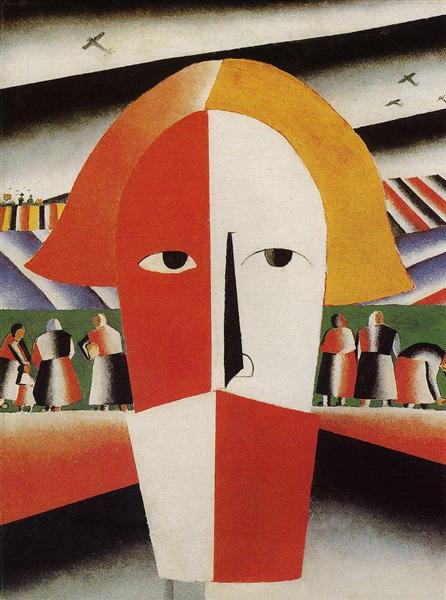Description
Kazimir Malevich, a spinal cord figure of the Russian Supreme Movement, presents us in "Campesino Head" (1929) a painting that may seem simple, but that, under a more detailed inspection, reveals a symbolic complexity and richness that deserves a Deep attention. In this work, Malevich not only reflects a portrait, but also articulates its aesthetic and philosophical concerns.
The painting presents a human figure in a stylized and abstract way, echoing the unique style of Malevich in its last years, when it sought to reincorporate recognizable forms to its visual language without completely abandoning its devotion due to geometric abstraction. The head of the peasant, with its simplified and delineated factions with hard contours, floats in a smooth background, which gives the portrait a particular gravity and strips it from any context that could distract the spectator from the central figure.
The predominant colors in "Campesino head" are red, white and black, a limited but shocking palette that accentuates the solemn and almost totemic character of the figure. The use of red, a color that historically evokes both vitality and sacrifice, could be interpreted as an allusion to the suffering and dignity of the peasant class, a recurring theme in Malevich's work, especially in the socio-political context of Post-revolutionary Russia.
The compositional structure is simple and direct. The peasant's head occupies the center of the composition, thus attracting all the viewer's attention. However, the rigorously flat and schematic nature of this head breaks with the Renaissance tradition of three -dimensional portrait, thus subverting expectations and forcing the observer to receive the figure in a more introspective and meditative way. Here, Malevich seems to suggest that there is a deeper and more essential truth that transcends the mere external appearance.
The historical context in which Malevich created this work adds additional layers of meaning. At the end of the 1920s, the Soviet Russia experienced enormous social and economic changes. Forced collectivization and agricultural policies had a hard impact on peasant life. "Campesino head", although abstract in his style, can be seen as a mention of those tumultuous times and individuals anonymized by the great movements of history.
Compared to other works by Malevich, such as his famous "Black Square" (1915) that represents the cusp of his suprematist exploration, "Campesino Head" marks a return to the human figure, although through the reductive and stylized lens that characterizes its mature aesthetic. It is remarkable how the figure is erected not only as a simple portrait, but as a symbol of resilience and persistence, a tribute to the essential humanity that Malevich considered immutable, despite the agitation of modernity.
In summary, "Campesino Head" by Kazimir Malevich is a work that encapsulates his persistent exploration of simplicity and essence, using an economy of shapes and colors to transmit a deeply human and reflective message. It is a piece that, like many of his works, invites the viewer to look beyond the surface and to consider the deepest dimensions of human existence.
KUADROS ©, a famous paint on your wall.
Hand-made oil painting reproductions, with the quality of professional artists and the distinctive seal of KUADROS ©.
Art reproduction service with satisfaction guarantee. If you are not completely satisfied with the replica of your painting, we refund your money 100%.

